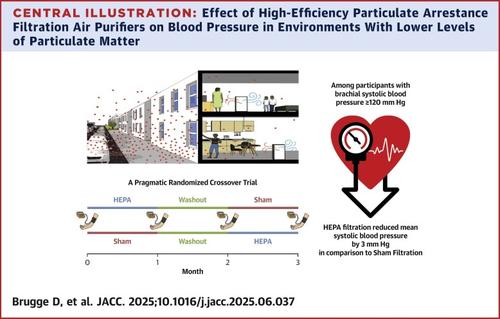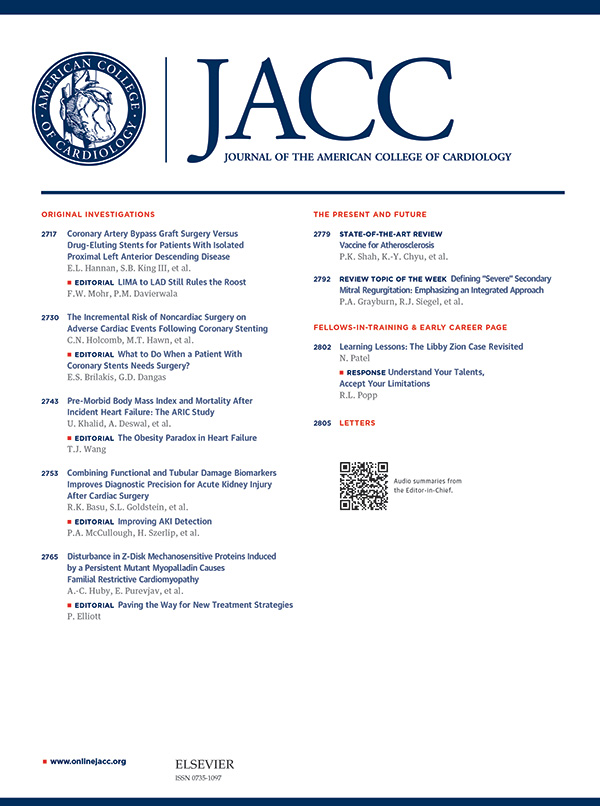HEPA过滤空气净化器对血压的影响:一项实用的随机交叉试验
IF 22.3
1区 医学
Q1 CARDIAC & CARDIOVASCULAR SYSTEMS
引用次数: 0
摘要
颗粒物(PM)污染是心血管风险和疾病的主要原因,包括血压升高。目的本研究的目的是测试家用空气净化器对居住在高速公路附近的成年人降低血压的效果。方法我们进行了一项实用的随机交叉试验,比较高效微粒捕集(HEPA)与假过滤对血压的影响。患者被随机分为两组,一组进行1个月的HEPA过滤,另一组进行1个月的假过滤。在1个月的无过滤冲洗期之后,进行1个月的交替过滤。在每个过滤期开始和结束时,收集参与者问卷数据和血压4次。在一部分住宅中测量了PM浓度。采用线性混合模型比较HEPA和假过滤期间BP的平均变化。对模型进行时不变和时变协变量调整。结果共分析了154名参与者。平均年龄为41.1岁,59.7%为女性,68.2%为非西班牙裔白人,大多数为较高的社会经济地位。平均基线肱收缩压(SBP)/舒张压为118.8/76.5 mm Hg。与室内和室外水平相比,HEPA过滤显著降低了PM。干预期开始时参与者的收缩压调节了干预的效果(P = 0.03)。臂收缩压升高(≥120 mm Hg)的参与者在HEPA过滤后收缩压平均降低2.8 mm Hg (P = 0.03),假性过滤后收缩压平均升高0.2 mm Hg (P = 0.85)。净结果是有利于HEPA过滤的3.0 mm Hg平均差异显著(P = 0.04)。舒张压或收缩压正常(<120 mm Hg)的参与者没有明显的益处。结论在PM2.5浓度相对较低的环境中,使用家用HEPA空气净化器可使收缩压升高的患者的收缩压降低,具有重要的临床意义。本文章由计算机程序翻译,如有差异,请以英文原文为准。

Effect of HEPA Filtration Air Purifiers on Blood Pressure: A Pragmatic Randomized Crossover Trial
Background
Particulate matter (PM) pollution is a leading cause of cardiovascular risk and illness, including elevated blood pressure (BP).Objectives
The purpose of this study was to test the efficacy of in-home air purifiers to reduce BP for adults living adjacent to highways.Methods
We conducted a pragmatic randomized crossover trial of the effect of high-efficiency particulate arrestance (HEPA) vs sham filtration on BP. Residences were randomized to start with 1 month of HEPA filtration or 1 month of sham filtration. A 1-month wash out period with no filtration was followed by 1 month of the alternate filtration. Participant questionnaire data and BP were collected 4 times, at the start and end of each filtration period. PM concentrations were measured in a subset of residences. Linear mixed models were used to compare the mean change in BP between the HEPA and sham filtration periods. Models were adjusted for time invariant and time-varying covariates.Results
A total of 154 participants were analyzed. The mean age was 41.1 years, 59.7% were women, 68.2% were non-Hispanic White, and a majority were of higher socioeconomic status. The mean baseline brachial systolic blood pressure (SBP)/diastolic BP was 118.8/76.5 mm Hg. HEPA filtration significantly reduced PM in comparison to both indoor sham and outdoor levels. Participants’ SBP at the start of the intervention period moderated the efficacy of the intervention (P = 0.03). Participants who had elevated brachial SBP (≥120 mm Hg) had a significant 2.8-mm Hg mean reduction in SBP after HEPA filtration (P = 0.03) and a 0.2-mm Hg mean increase in SBP after sham filtration (P = 0.85). The net result was a significant 3.0-mm Hg mean difference in favor of HEPA filtration (P = 0.04). There was no significant benefit on diastolic BP or for participants with normal SBP (<120 mm Hg).Conclusions
The use of in-home HEPA air purifiers resulted in clinically important reductions in SBP for people with elevated SBP in environments with relatively low PM2.5 concentrations.求助全文
通过发布文献求助,成功后即可免费获取论文全文。
去求助
来源期刊
CiteScore
42.70
自引率
3.30%
发文量
5097
审稿时长
2-4 weeks
期刊介绍:
The Journal of the American College of Cardiology (JACC) publishes peer-reviewed articles highlighting all aspects of cardiovascular disease, including original clinical studies, experimental investigations with clear clinical relevance, state-of-the-art papers and viewpoints.
Content Profile:
-Original Investigations
-JACC State-of-the-Art Reviews
-JACC Review Topics of the Week
-Guidelines & Clinical Documents
-JACC Guideline Comparisons
-JACC Scientific Expert Panels
-Cardiovascular Medicine & Society
-Editorial Comments (accompanying every Original Investigation)
-Research Letters
-Fellows-in-Training/Early Career Professional Pages
-Editor’s Pages from the Editor-in-Chief or other invited thought leaders

 求助内容:
求助内容: 应助结果提醒方式:
应助结果提醒方式:


